
Each time NASA's Galileo spacecraft orbits the planet Jupiter, it encounters one of the four Galilean satellites. From left to right in this mosaic, the moons shown are Io, Europa, Ganymede, and Callisto. Throughout the eleven orbits in Galileo's nominal mission the Solid State Imaging (CCD) system builds up views of the satellite surfaces in different colors and at varying spatial resolutions.
The top row displays the correct relative sizes of the satellites in global views. In these relatively low resolution images the smallest features that can be seen are about 20 kilometers in size. These views show how the surfaces have been affected on the largest scales by either tectonic or volcanic changes in the interiors of the moons or by deposition from the exterior environment. In the middle row the picture resolutions are up to ten times higher and are suitable for investigations of the dominant regional features that are seen, such as fields of volcanic caulderas on Io (the black spots), tidally induced cracks thousands of kilometers long on Europa, bright grooved regions on Ganymede's extended surface, and enormous impact basins on Callisto due to hypervelocity impacts with primitive comets or asteroids. The bottom row displays views typical of the highest resolutions that have been achieved (up to about 20 meters) and which are used to study the nature and physical origins of individual structures on the surface, such as the individual vents from which volcanic plumes originate on Io, the ridges that are everywhere on Europa, the fractured and pulled apart grooved terrain on Ganymede, or the heavily eroded and mantled craters on Callisto.
The colors in several of these images represent views in spectral regions that are not visible to the eye. They show either differences in surface chemical composition or changes in the way the surface reflects sunlight. For example in the left middle image, bright red depicts material newly ejected from an active volcano on Io and the surrounding yellow materials are older sulphur deposits. The picture to its right shows enormous cracks in the ice shell that forms the surface of Europa. Blue represents ice and reddish areas probably represent a thin coating of darker material ejected by ice volcanoes that occur along the cracks.
Galileo has not yet completed its survey of the Galilean satellites (This will occur late in 1999 with a very close flyby of Io that should produce images of unprecedented resolution, up to 6 meters, on its surface.) and for this reason some of the images that have been used in this montage, such as the high resolution image showing individual volcanic vents on Io which shows details down to 350 meters in size, come from the previous mission to Jupiter, Voyager.
North is to the top of the pictures. The top row shows global color views of all satellites which have been scaled to about 10 kilometers (km) per picture element (pixel). The middle row shows regional color views, each covering an area about 1000 km by 750 km and scaled to about 1.8 km per pixel. The bottom row shows black and white views covering areas about 100 km by 75 km and scaled to about 180 meters per pixel. The Callisto global, Ganymede regional, and Io high resolution views were acquired in 1979 by NASA's Voyager spacecraft. Most of the images in this montage were acquired between June of 1996 and June of 1997 by the solid state imaging (CCD) system on NASA's Galileo spacecraft.
Io
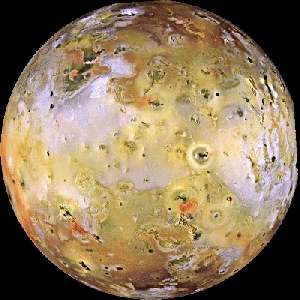
Io's surface is radically different from any other body in the solar system. It came as a very big surprise to the Voyager scientists on the first encounter. They had expected to see impact craters like those on the other terrestrial bodies and from their number per unit area to estimate the age of Io's surface. But there are very few, if any, impact craters on Io. Therefore, the surface is very young.
Instead of craters, Voyager 1 found hundreds of volcanic calderas. Some of the volcanoes are active! Striking photos of actual eruptions with plumes 300 km high were sent back by both Voyagers and by Galileo. This may have been the most important single discovery of the Voyager missions; it was the first real proof that the interiors of other "terrestrial" bodies are actually hot and active. The material erupting from Io's vents appears to be some form of sulfur or sulfur dioxide. The volcanic eruptions change rapidly. In just four months between the arrivals of Voyager 1 and Voyager 2 some of them stopped and others started up. The deposits surrounding the vents also changed visibly.
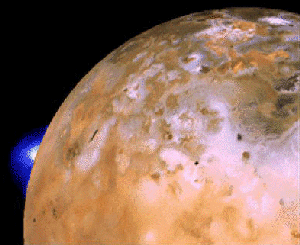
Recent images taken with NASA's Infrared Telescope Facility on Mauna Kea, Hawaii show a new and very large eruption (above). A large new feature near Ra Patera has also been seen by HST. Images from Galileo also show many changes from the time of Voyager's encounter. These observations confirm that Io's surface is very active indeed.
Io has an amazing variety of terrains: calderas up to several kilometers deep, lakes of molten sulfur (below right), mountains which are apparently NOT volcanoes (left) extensive flows hundreds of kilometers long of some low viscosity fluid (some form of sulfur?), and volcanic vents. Sulfur and its compounds take on a wide range of colors which are responsible for Io's variegated appearance.
Analysis of the Voyager images led scientists to believe that the lava flows on Io's surface were composed mostly of various compounds of molten sulfur. However, subsequent ground-based infra-red studies indicate that they are too hot for liquid sulfur. One current idea is that Io's lavas are molten silicate rock. Recent HST observations indicate that the material may be rich in sodium. Or there may be a variety of different materials in different locations.
Some of the hottest spots on Io may reach temperatures as high as 2000 K though the average is much lower, about 130 K. These hot spots are the principal mechanism by which Io loses its heat. The energy for all this activity probably derives from tidal interactions between Io, Europa, Ganymede and Jupiter. These three moons are locked into resonant orbits such that Io orbits twice for each orbit of Europa which in turn orbits twice for each orbit of Ganymede. Though Io, like Earth's Moon always faces the same side toward its planet, the effects of Europa and Ganymede cause it to wobble a bit. This wobbling stretches and bends Io by as much as 100 meters (a 100 meter tide!) and generates heat the same way a coat hanger heats up when bent back and forth. (Lacking another body to perturb it, the Moon is not heated by Earth in this way.)
Io also cuts across Jupiter's magnetic field lines, generating an electric current. Though small compared to the tidal heating, this current may carry more than 1 trillion watts. It also strips some material away from Io which forms a torus of intense radiation around Jupiter. Particles escaping from this torus are partially responsible for Jupiter's unusually large magnetosphere.
Recent data from Galileo indicate that Io may have its own magnetic field as does Ganymede. Io has a thin atmosphere composed of sulfur dioxide and perhaps some other gases. Unlike the other Galilean satellites, Io has little or no water. This is probably because Jupiter was hot enough early in the evolution of the solar system to drive off the volatile elements in the vicinity of Io but not so hot to do so farther out.
Europa
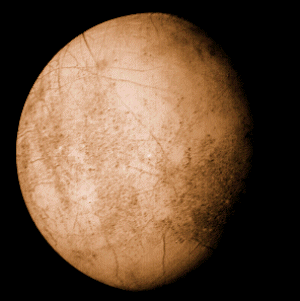
Europa and Io are somewhat similar in bulk composition to the terrestrial planets, primarily composed of silicate rock. Unlike Io, however, Europa has thin outer layer of ice. Recent data from Galileo indicate that Europa has a layered internal structure perhaps with a small metallic core.
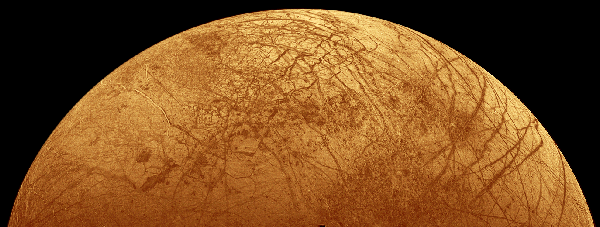
But Europa's surface is not at all like anything in the inner solar system. It is exceedingly smooth. Few features more than a few hundred meters high have been seen. The prominent markings seem to be only albedo features or very low relief.
There are very few craters on Europa; only three craters larger than 5 km in diameter have been found. This would seem to indicate a young and active surface. However, the Voyagers mapped only a fraction of the surface at high resolution. The precise age of Europa's surface is an open question.
The images of Europa's surface strongly resemble images of sea ice on Earth. It is possible that beneath Europa's surface ice there is a layer of liquid water, perhaps as much as 50 km deep, kept liquid by tidally generated heat. If so, it would be the only place in the solar system besides Earth where liquid water exists in significant quantities.
Europa's most striking aspect is a series of dark streaks crisscrossing the entire globe. The larger ones are roughly 20 km across with diffuse outer edges and a central band of lighter material. The latest theory of their origin is that they are produced by a series of volcanic eruptions or geysers.
Recent observations with HST reveal that Europa has a very tenuous atmosphere (1e-11 bar) composed of oxygen. Of the 61 moons in the solar system only four others (Io, Ganymede, Titan and Triton) are known to have atmospheres. Unlike the oxygen in Earth's atmosphere, Europa's is almost certainly not of biologic origin. It is most likely generated by sunlight and charged particles hitting Europa's icy surface producing water vapor which is subsequently split into hydrogen and oxygen. The hydrogen escapes leaving the oxygen.
The Voyagers didn't get a very good look at Europa. But it is a principal focus of the Galileo mission. Images from Galileo's first two close encounters with Europa seem to confirm earlier theories that Europa's surface is very young: very few craters are seen, some sort of activity is obviously occurring. There are regions that look very much like pack-ice on polar seas during spring thaws on Earth. The exact nature of Europa's surface and interior is not yet clear but the evidence is now strong for a subsurface 'ocean'.
Galileo has found some evidence of a weak magnetic field (perhaps 1/4 of the strength of Ganymede's).
Ganymede
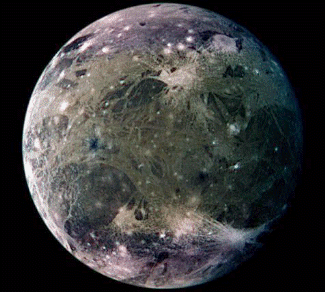
Ganymede is the largest satellite in the solar system. It is larger in diameter than Mercury but only about half its mass. Ganymede is much larger than Pluto.
Before the Galileo encounters with Ganymede it was thought that Ganymede and Callisto were composed of a rocky core surrounded by a large mantle of water or water ice with an ice surface (and that Titan and Triton were similar). Preliminary indications from the Galileo data now suggest that Callisto has a uniform composition while Ganymede is differentiated into a three layer structure: a small molten iron or iron/sulfur core surrounded by a rocky silicate mantle with a icy shell on top. In fact, Ganymede may be similar to Io with an additional outer layer of ice.
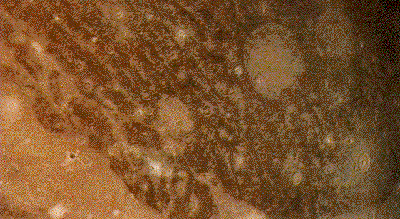
Ganymede's surface is a roughly equal mix of two types of terrain: very old, highly cratered dark regions (left), and somewhat younger (but still ancient) lighter regions marked with an extensive array of grooves and ridges. Their origin is clearly of a tectonic nature, but the details are unknown. In this respect, Ganymede may more similar to the Earth than either Venus or Mars (though there is no evidence of recent tectonic activity).
Evidence for a tenuous oxygen atmosphere on Ganymede, very similar to the one found on Europa, has been found recently by HST (note that this is definitely NOT evidence of life).
Similar ridge and groove terrain is seen on Enceladus, Miranda and Ariel. The dark regions are similar to the surface of Callisto.
Extensive cratering is seen on both types of terrain. The density of cratering indicates an age of 3 to 3.5 billion years, similar to the Moon. Craters both overlay and are cross cut by the groove systems indicating the the grooves are quite ancient, too. Relatively young craters with rays of ejecta are also visible.
Unlike the Moon, however, the craters are quite flat, lacking the ring mountains and central depressions common to craters on the Moon and Mercury. This is probably due to the relatively weak nature of Ganymede's icy crust which can flow over geologic time and thereby soften the relief. Ancient craters whose relief has disappeared leaving only a "ghost" of a crater are known as palimpsests.
Galileo's first flyby of Ganymede discovered that Ganymede has its own magnetosphere field embedded inside Jupiter's huge one. This is probably generated in a similar fashion to the Earth's: as a result of motion of conducting material in the interior.
Callisto
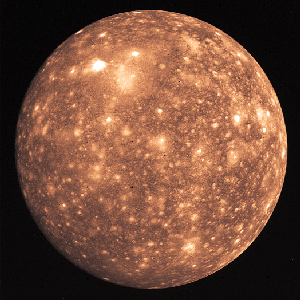
Callisto is only slightly smaller than Mercury but only a third of its mass. Unlike Ganymede, Callisto seems to have little internal structure; However there are signs from recent Galileo data that the interior materials have settled partially, with the percentage of rock increasing toward the center. Callisto is about 40% ice and 60% rock/iron. Titan and Triton are probably similar.
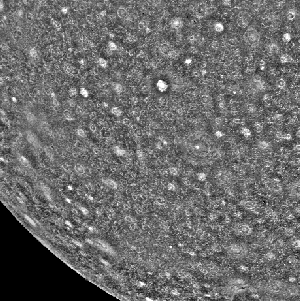
Callisto's surface is covered entirely with craters. The surface is very old, like the highlands of the Moon and Mars. Callisto has the oldest, most cratered surface of any body yet observed in the solar system; having undergone little change other than the occasional impact for 4 billion years.
The largest craters are surrounded by a series of concentric rings which look like huge cracks but which have been smoothed out by eons of slow movement of the ice. The largest of these has been named Valhalla. 4000 km in diameter, Valhalla is a dramatic example of a multi-ring basin, the result of a massive impact. Other examples are Callisto's Asgard Mare Orientale on the Moon and Caloris Basin on Mercury.

Like Ganymede, Callisto's ancient craters have collapsed. They lack the high ring mountains, radial rays and central depressions common to craters on the Moon and Mercury. Detailed images from Galileo show that, in some areas at least, small craters have mostly been obliterated. This suggests that some processes have been at work more recently, even if its just slumping.

Another interesting feature is Gipul Catena, a long series of impact craters lined up in a straight line. This was probably caused by an object that was tidally disrupted as it passed close to Jupiter (much like Comet SL 9) and then impacted on Callisto.
Callisto has a very tenuous atmosphere composed of carbon dioxide. Galileo has detected no evidence of a magnetic field.
Unlike Ganymede, with its complex terrains, there is little evidence of tectonic activity on Callisto. While Callisto is very similar in bulk properties to Ganymede, it apparently has a much simpler geologic history. The different geologic histories of the two has been an important problem for planetary scientists; (it may be related to the orbital and tidal evolution of Ganymede). "Simple" Callisto is a good reference for comparison with other more complex worlds and it may represent what the other Galilean moons were like early in their history.
Back To Main Menu
Use the "BACK" button on your Browser to return to the previous page.